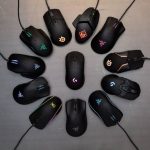Screen Tearing: What is it & How to Fix it?
Screen tear is a graphics problem that results in unsightly visual artifacts on the screen. It’s a frequent problem among gamers, and it’s particularly aggravating if you’re broadcasting or recording your games. But why does it happen in the first place? What’s more, how can you get rid of screen tearing?
Before we get into that, it’s important to understand what screen tearing is and how your gaming display and graphics card operate.
What is the definition of screen tearing?
When your display can’t keep up with your graphics card, you’ll have screen tearing! It’s when you receive more than one frame on your display, either horizontally or vertically, spoiling your gaming experience completely.
Why does screen tearing occur in the first place?
The GPU must maintain a continuous duplicate of the matching picture in its memory for the display unit to know what it should display (technically known as the front buffer.) Pixel by pixel, frame by frame, the monitor pulls this data from the front buffer and displays it.
If you’re wondering, this is one of the reasons you should buy a graphics card with a lot of VRAM (Virtual RAM – the name for graphics card memory).
Monitors display an updated version of the picture at dizzying rates when it comes to gaming. However, the graphic’s fps display can only function at its maximum refresh rates (technically).
If you have a 144Hz gaming monitor, you should be aware that it can only display 144 frames per second. This isn’t even close to what professional esports players utilize. In any case, anything more than 144 frames per second doesn’t cause a celebration. Instead, you’ll get a lot of screen rip.
How Does Screen Tearing Appear?
Screen tear will result in two frames separated by a boundary that any gamer may readily see. On that particular occasion, it seems like the monitor has shown two incomplete frames. Here are a few instances of screen tearing.
What Causes Tearing on a Screen?
In the picture above, look at the frame between the blue arrows. On the screen, you’ll see two incomplete frames. These ripped pictures usually only stay on the screen for a fraction of a second. However, it is noticeable in a significant number of popular gaming titles. The reason for this can be traced back to high-performance GPUs, which can render games at considerably faster frame rates than monitors can.
The majority of LCD monitors have a refresh rate of 60 Hz, which means they can display up to 60 frames per second. Keep in mind that these frames may have the greatest display resolution and visual quality.
The visual quality shown has nothing to do with the display refresh rate!
So, whether you’re running the game with custom-high graphics settings or not, if the graphics card is producing 80 or 90 frames per second, you’re sure to see screen tearing on your 60 Hz display!
How to Repair Tears in a Screen
Solution 1: Using Adaptive display software
Vertical Sync, often known as V-Sync, is the most frequent screen tearing remedy. Many games include this option in the graphics control panel or even in geographical settings. V-Sync causes the GPU to reduce the number of frames displayed to match the display’s maximum refresh rate.
V-Sync is prone to stuttering and latency. Why?
Your CPU is constantly reducing the GPU’s rendered frames to match the display’s refresh rates. When you enable V-Sync, you’re asking your CPU to perform an extra control function while the game is running. It goes without saying that if your CPU is overworked, you will experience input latency.
AMD FreeSync is another option for preventing screen tearing. Unlike V-Sync, it can do so without producing stuttering. Adaptive Sync allows FreeSync to operate via the DisplayPort.
What is Adaptive Sync, and how does it work?
Adaptive-Sync dynamically adjusts the monitor’s refresh rates to match the GPU fps, rather than lowering the graphics card’s fps outputs.
As it works via the extra DisplayPort, FreeSync minimizes screen tearing, stuttering, and input latency. Adaptive Sync operates at a frequency of 30 to 144 Hz.
How to use FreeSync?
You’ll need a FreeSync monitor (but a G-Sync compliant monitor would suffice!) to utilize this function. A DisplayPort version 1.2A input with an optional Adaptive-Sync functionality in the firmware will be required for compatible monitors.
With a top-of-the-line G Sync monitor, you can do better than FreeSync. Even yet, it’s hard to envision a gamer with a G Sync display experiencing screen tearing!
Solution 2: Ensure that your graphics drivers are up to date.
Graphics Drivers Should Be Checked/Updated
This graph depicts gaming performance on Battlefield 3 using various graphics drivers. Graphics cards are one of the few pieces of hardware that get regular driver upgrades.
The first step in any graphics card troubleshooting is to make sure you have the most recent driver. Updated drivers may result in more consistent frame rates.
Although it has no case of on-screen tearing, upgrading graphics drivers may help to reduce stuttering if your frame rate falls below the refresh rate of your monitors. As a result, the V-Sync option will have a better chance of minimizing screen tearing.
G-Sync from NVIDIA vs. FreeSync from AMD
Is NVIDIA G Sync superior to AMD FreeSync in terms of graphics performance? Yes, it certainly does. Is G Sync, on the other hand, superior to AMD FreeSync? No, not for everyone.
Despite being a proprietary AMD program, FreeSync utilizes the open-source Adaptive-Sync protocol, which is widely available on third-party scalers. Any monitor would be incomplete without these scalars.
FreeSync is, as the name implies, completely free to use. G-Sync, on the other hand, relies only on a scaler module developed by NVIDIA. NVIDIA sells this module to display makers that wish to create G-Sync monitors.
G-Sync devices are much more costly than standard or G-Sync compatible devices. And it’s for this reason that G-Sync isn’t just superior to AMD FreeSync. AMD FreeSync provides better value for money than G-Sync for the typical gamer. With G-Sync compatible Freesync monitors, you can enjoy a little bit of both!
Finally,
You’ll come across a variety of methods that promise to fix screen tearing. Screen tearing, on the other hand, is an issue with no easy fix (apart from buying a better display!). In the case of a financial emergency, you may use V-Sync and update drivers. Alternatively, if you have the funds, invest in a monitor that supports FreeSync or G-sync; nothing beats that!


